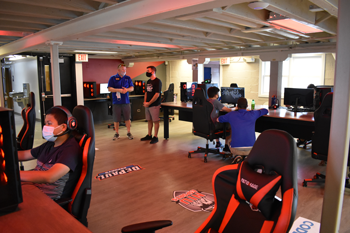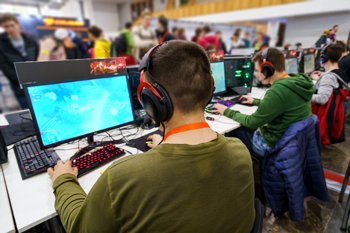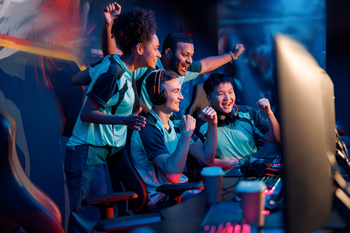There’s a recreational phenomenon in the U.S. that has exploded in the past 10 years. It’s not coming to a community near you—it’s been there for decades.
Esports, or as they’ve been known since their inception in the 1980s, competitive video gaming, have migrated from living rooms to college campuses and high-tech specialized arenas. There are professionals, varsity and JV squads, endorsements, and scholarships. Associations and leagues and consultants, architects and coaches, celebrities and increasingly, park district facilities and programming.
Enabled by the internet’s ability to link gamers across the country and world, esports has become a spectator sport complete with in-person fan attendance and the much larger viewing capability afforded by broadcast technology and streaming technology. It’s been reported that 261 million people watch esports at least once a month.
Revenue for esports globally in 2021 was $1.2 billion. So how can recreational managers and operators take advantage of this participation and interest to not only to serve the community but also make some money?

As with any new programming that requires a capital investment—in this case for space and technology—administrators should survey their area, said Michael Brooks, executive director of the National Association of College Esports. Because college esports programs are much more common—NACE claimed 475 clubs on campuses across the country in 2019—and better established than community parks and rec esports programs, college startup stories are instructive for recreation managers.
“We always encourage administrators to check with their student bodies first before launching any major initiative in esports to understand if clubs already exist on campus,” Brooks said. “Understanding who would be interested in reserving an esports arena and including those groups in the discussions is an important step in building communities.”
Brooks’ organization and others have breakdowns on costs for those mulling an esports center. The costs don’t change whether the launch is for varsity college teams or municipal facilities; space and the right computers are necessary. The average startup cost is $41,000, according to Baker Tilly, a business advisory firm that added esports to its offerings.
Just as parks and rec departments are tasked with attracting and retaining community members to their facilities, colleges desperate to raise enrollment have latched onto esports as magnets for kids who could choose one campus over another for its esports clubs and teams.
“From a higher education standpoint, many of our clients and peers in the industry recognize esports as an opportunity for belonging on campus,” said Baker Tilly managing partner Dave Capitano. “Now there is a club or, at many colleges, a varsity or JV team for esports. Students who enjoy and excel at playing video games competitively can now belong to a team or a student organization with shared values and interests, on campus.
“This goes a long way in terms of student engagement and success, especially during this crucial time for institutions to prioritize student mental health and well-being.”
A blog post from CivicPlus titled “Why Every Parks and Recreation Department Needs an Esports Offering and How to Get Started” emphasizes that care must be taken to ensure a program launch is successful. After deciding to create a program and investing in space and equipment because a community survey deemed it worth the risk, managers must raise awareness.
“Sell it as the cool, new, and unique activity that it has the potential to be,” the article states. “Work with schools, libraries, and after-school programs to distribute flyers and information. Make materials eye-catching while ensuring they appeal to parents.”
This is where esports launches differ from more traditional activities. Parents want new, constructive activities for their kids, but video games have been and can still be seen as time wasting and sedentary. “Do your best to curb this perception with detailed communication of program details, goals, and benefits,” the article states. “Competitive gaming in a group setting can provide many of the same lessons and skill building—such as teamwork and effective communication—as physical team sports. It’s a matter of perception.
“Provide statistics and data, and show that your program is a structured, positive opportunity for change and development where youth can have fun, develop friendships, and build important social skills.”
Be sure to remember that esports are not just for kids. One report showed that as many as 65% of American adults play video games, so it might be a mistake to gear awareness campaigns to those under 18 only.
Other advice from the article looks pretty similar to suggestions for starting any program:
- Use staff as coaches or program leaders.
- Gauge interest and then plan a functional space with technology and hardware, adjusting as you go.
- Plan events and invite an audience to attract participants and build community relationships.
- Allow participants to register for events.
- Pursue sponsorships and partnerships from local gaming businesses.
- Create rules, practice, schedules and exercises.
- Hold all-age events as well as age-group-specific programs.
- Develop mentorship opportunities for kids that may need positive role models.
- Use constructive, positive games—sports games, puzzle games and creative games.
- Post results, successes, team trophies or accomplishments on your website and social media to attract interest and promote the program.
- Hold tournaments within your local groups or connect with other neighboring communities and beyond.

Alisa Kapusinski is the recreation director for Hoffman Estates Park District in Illinois, and is one of the few across the U.S. who knows what it takes to try to add esports to a parks and rec catalog. She said the effort began not with community demand but in response to the growing popularity. While attending multiple trends-in-recreation sessions at national conferences, Kapusinski and her staff kept hearing more and more about esports.
“Since we knew this was an up-and-coming trend, we added the development of esports into our annual goals and objectives for 2020,” she said. “We are always striving to add more and do new programs so this just seemed to fit our district’s goals.”
The department’s first task for the project was to secure a location for an esports facility. Within the district was a teen center housed in the lower level of a barn. The teen center had seen decreasing participation through the years so the department chose to revamp the space.
All of the renovation work was done by the district’s maintenance department: a new coat of paint on the walls and new flooring. The maintenance crew also made customized tables for the computers because structural beams presented obstacles.
“We then worked with our IT department to determine all the equipment that had to be purchased,” said Kapusinski. “In addition, the IT department took the lead on ensuring we had strong enough internet capabilities to serve all the computers.”
While the facility was being built, Kapusinski’s team worked with the district’s communications and marketing team to begin creating the brand, E-Sports Zone. They designed a logo for the facility and a webpage for promotions.
The recreation team created the operations plan, which included monthly unlimited membership, drop-in fees and programs, including tournaments and Kids Night Out events.
The space was completed in spring of 2021 with a soft opening. Since Illinois had strict COVID guidelines through 2020 and much of 2021 the facility couldn’t open with a large event. A larger grand opening was held in fall 2021 with two local esports college teams attending.
The facility is still open, but the drop-in hours have been eliminated due to lower attendance, Kapusinski said. The facility is solely used now for tournaments, events and birthday parties, the latter of which is the main revenue generator for the space. Kapusinski said she learned a lot from the experience, which was marred by COVID restrictions.
“Some of the challenges we faced were: opening during the pandemic, educating the community on the benefits of esports—meaning some people within the community only think of recreation as active sports—showing the value of paying to play at our facility versus staying at home and still playing with others socially, but not having to play elsewhere, and our market is the youth and young teens,” Kapusinski said.
“I believe that there is a strong market with adult gamers, but (that) group of gamers is looking for more of an entertainment venue than a community room.”
Kapusinski said her experience does not mean esports can’t work for park districts.
“I believe there is value in bringing the esports athletes together to enjoy gaming in a social setting,” she said. “Everyone enjoys watching each other play and compete together. However, I don’t believe that the facility has brought in the revenue to cover the costs associated with the development and upkeep of the operations.”
She suggests to others that they try to partner with a local college or high school and rent or use their space before looking to build a space for their district.
“Maybe even partner with these groups to set up some mentoring programs,” she suggested.
Once a space is chosen and equipment purchased, operators can turn to a company like GGLeagues, which provides a platform for players to join clubs and teams and play others. GGLeagues provides rules and conduct guidelines with zero tolerance for swearing, sexism, bullying, racism, homophobic remarks, taunting and lewd remarks.
Ensuring good behavior is one way to provide parents with some assurances that a department’s esports program isn’t the Wild West.
“Our experienced team of moderators, referees and league managers will be on staff during every game, in order to ensure everyone is staying within our code of conduct and guidelines,” states one part of the parent page at the GGLeagues website. “Should any code of conduct breach or toxicity occur, our moderators will always be available to step in and de-escalate the situation.”
The company also offers ways for parents to monitor and manage what leagues and tournaments their kids play in. Any private information is secure and never shared and private communications between players are monitored. Kids play in leagues with others of their age.
“Through our methods, we ensure that players are watched and cared for every step of the way in their competitive gaming journey,” said the site.
GGLeagues touts the benefits of esports participation, providing a guide for managers when they sell esports programs and investment to their bosses and communities. Kids can learn time management, critical thinking skills, teamwork, problem-solving skills and envision working in the esports industry. They can also earn scholarship money.
In 2019 universities awarded $15 million in scholarships. NACE, not the only national college esports association, has a board of directors, a competition council and an eligibility enforcement committee. All members of those bodies are representatives of a university or college.
Brooks said for students who aren’t quite as competitive but still enjoy esports, there’s a growing trend for varsity programs to help form clubs and mesh with campus recreational facilities. There is much overlap of gaming equipment regardless of the level and status of competition, he said. He cited one university maximizing its esports facility’s revenue generation by operating it as an internet cafe.
“Thankfully, the equipment needs between a professional team and a recreational team, in terms of competition, are not different,” said Brooks. “A high-powered gaming PC and strong internet connection work for both. The primary difference we see between the two groups is the need for recording equipment for broadcasts and staging equipment.
“We’ve seen institutions be incredibly successful in utilizing existing computer labs, assuming the PCs are powerful enough, as their esports facilities. If this situation is possible, your facility’s expenses are almost entirely mitigated. On the other hand, we’ve seen other institutions with substantial resources build dedicated esports facilities and associated classrooms and broadcasting suites for their esports programs. The tie between competitive space and associated educational outcomes has been growing rapidly as universities use their esports programs as a vehicle to achieve educational goals.”
There are now architectural firms that have specialists in designing esports spaces. Populous is one such company, and its work with Butler University in Indianapolis is an example of a multi-use facility satisfying varsity program, club and community users. The 7,500-square-foot Butler Esports Park opened in the fall of 2022.
According to the Populous website, the designers included a co-working and lounge area with a mix of social seating, collaborative technology and gaming areas. It features a café to serve students and the community on a daily basis, and up to 60 gaming stations for everyday student use, varsity team training and collegiate competition.
The broadcast and production space needed for varsity gaming and content creation also is a resource for academic development and experiential learning.
“There was a lot of attention to detail in the design in order to gain maximum operational functionality of the space,” Eric Kammeyer, Butler University’s director of esports and gaming technology said in a Populous blog post. “Through our partnership with Populous, we have created an innovative and versatile space that will serve our esports teams as well as students and the community, creating more opportunities for them to excel.”
Baker Tilly’s Capitano said that intersection of fun, serious competition, skills-building, scholarship money and career opportunities make dedicated esports facilities a force that is here to stay. He cites Florida Tech’s efforts to work with institutional leadership to integrate esports into the institution’s STEM programs, which in turn can help lead to new and more career opportunities and nationwide growth in esports.
“It is just the beginning for this digital playing field,” he said. “Emerging industries and trends that are or have a strong digital component are the future, and we envision more and more institutions establishing and/or enhancing esports programs.
“Look around various cities, read the daily newspaper and you can see that esports is a growing phenomenon. Today—and I imagine into the future—colleges and universities are not only adding esports clubs and teams to their athletic programming, but to their academic programming too.” RM



